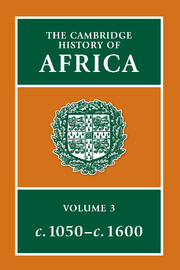Book contents
- Frontmatter
- Introduction: some interregional themes
- 1 Egypt, Nubia and the Eastern Deserts
- 2 Ethiopia, the Red Sea and the Horn
- 3 The East Coast, Madagascar and the Indian Ocean
- 4 The eastern Maghrib and the central Sudan
- 5 The western Maghrib and Sudan
- 6 Upper and Lower Guinea
- 7 Central Africa from Cameroun to the Zambezi
- 8 Southern Africa
- 9 The East African interior
- Bibliographical Essays
- Bibliography
- Index
- References
9 - The East African interior
Published online by Cambridge University Press: 28 March 2008
- Frontmatter
- Introduction: some interregional themes
- 1 Egypt, Nubia and the Eastern Deserts
- 2 Ethiopia, the Red Sea and the Horn
- 3 The East Coast, Madagascar and the Indian Ocean
- 4 The eastern Maghrib and the central Sudan
- 5 The western Maghrib and Sudan
- 6 Upper and Lower Guinea
- 7 Central Africa from Cameroun to the Zambezi
- 8 Southern Africa
- 9 The East African interior
- Bibliographical Essays
- Bibliography
- Index
- References
Summary
The third chapter of this volume has already shown how little connection there was between the brilliant medieval civilization of the East African coast and most of the vast interior which lay behind it. The Waqwaq of the tenth-century Arabic geographer al-Mas'ūdl might be the Makua of northern Mozambique. The Matamandalin of the Kilwa Chronicle might be the Matambwe of southern Tanzania. The sixteenth-century Portuguese identified by name three small ethnic groups living in the immediate hinterland of Malindi and Mombasa. There is one late medieval reference to people from the interior arriving at Mombasa carrying ivory tusks and skins on their heads. But there is no record of any penetration of the interior by Arabs or Swahili before the eighteenth century, and the only notable overland journey carried out by a Portuguese to the north of the Zambezi was that of Gaspar Bocarro from Tete to Kilwa in 1616. No significant collection of imported objects has yet been found at any interior site north of the Zambezi dating to the period before 1600.
The reasons for this strange disjunction between coast and interior are certainly in large measure geographical. Behind the narrow coastal plain, the land rises towards the great central plateau, in shelf after shelf of dry thorn scrub, hard to inhabit and difficult to cross. Much of the plateau stands at approximately 1,200 metres above sea level, and its eastern rim rises in places much higher. The Iringa highlands, the Ngulu mountains, the Usambara and Pare hills all rise above a height of 1,800 metres.
- Type
- Chapter
- Information
- The Cambridge History of Africa , pp. 621 - 669Publisher: Cambridge University PressPrint publication year: 1977
References
- 8
- Cited by



